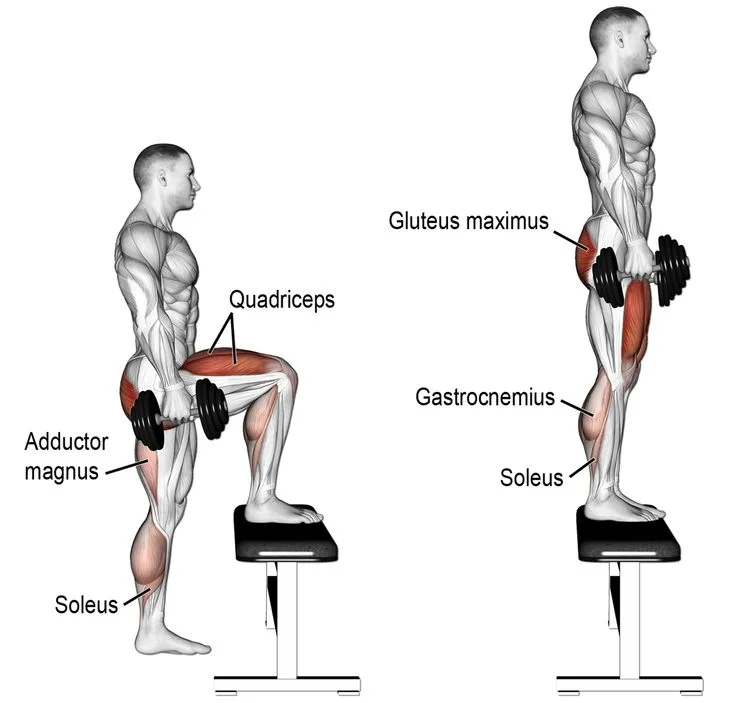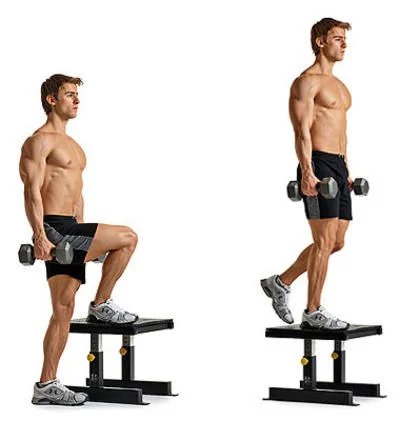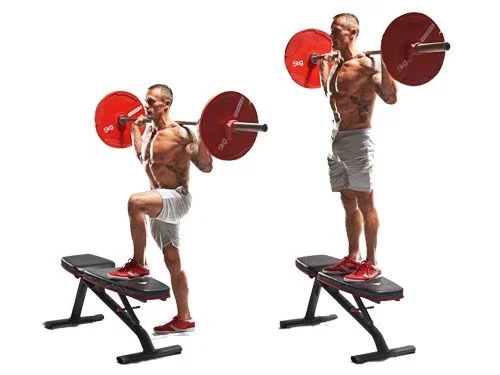The Dumbbell step-up is an excellent exercise for working your thighs, glutes, and quadriceps. By performing these exercises with a weight in your hand, you’re not only increasing your strength and conditioning but also your muscle size. If you’re looking to add some extra muscle mass without adding any weight, then the step-up is the perfect exercise for you.
What Is a Dumbbell Step-up?
The dumbbell step-up, sometimes known as the “dumbbell box step-up,” is a lower-body exercise performed by “stepping up” onto a knee-high box or bench while gripping a dumbbell in each hand.
While the step-up can be done with your body weight or a barbell, the most common variation (and the one we’ll cover in this post) is the dumbbell step-up.
dumbbell step-up benefits
The weighted step-up exercise is great for strengthening the quadriceps (the front of the thigh). Building quads protects the knee, and step-ups, when done correctly, provide less knee stress. (1)
Because your quads get little use when jogging or walking on flat terrain, you may need to exercise them to keep them in shape if they are your primary aerobic exercises. Step-ups also engage the posterior chain (glutes and hamstrings), which is crucial for climbing stairs, making this a useful exercise.
Because you must control the weight as you go up and down, forward and back, this exercise develops balance, stability, and proprioception. Another advantage is that it strengthens each leg individually, resulting in equal strength in each.
Step-ups can be done almost anywhere since the only equipment needed is a step, box, or bench and some weights. It is a great alternative to other low-body exercises such as plyometric jumping because it is easier to do and lower impact.
dumbbell step-up muscles worked

The main muscles worked by the dumbbell step-up are the . . .
- Glutes (2)
- Quadriceps
- Hamstrings
- Hip adductors
- Calves
dumbbell step-up form

How To Do Dumbbell Step-up Correctly
Instructions
- Set up for the dumbbell step-up by choosing a pair of dumbbells and holding them down at your sides.
- Stand up straight in front of a flat bench or other raised platform.
- Maintain a forward gaze and a tiny bend in your knees. This is your starting point.
- Lift your left knee and place your left foot on the platform.
- When your left foot is firmly planted on the platform, pull your torso up and place your right foot on the platform as well.
- Step back with your right leg and cautiously return to the starting position after a brief pause.
- Rep to this motion for the appropriate number of reps, then repeat while leading with your right foot.
Tips
- Throughout the workout, keep your head up and your back straight. Never let your back round.
- Raising the platform increases the intensity and difficulty. The more difficult the workout, the higher the platform.
- Begin with little to no weight. This workout demands a lot of balance, so proceed with caution.
Common Mistakes
To get the most from this exercise and lower the risk of injury, avoid these errors.
- Knee Out of Alignment: Your active leg’s knee should track across your second and third toes. It should not collapse in or out.
- Knee Passing Toes: When you step up, avoid pushing your active leg’s knee past your toes. Pushing the knee forward affects the muscles that are engaged and puts extra strain on the knee joint.
- Rounding the Back: To minimize stressing your knee joint, you may need to bend forward somewhat. Maintain as straight and erect a body as possible, keeping your chest up rather than rounding your back.
- Pushing Up With Lower Leg: The work should come from the leading leg, basically bringing the trailing leg up as dead weight. Pushing up with the lower leg reduces the load on the leading leg.
Dumbbell Step-up Variations
Dumbbell Step-Up with Knee Drive
The dumbbell step-up with knee drive is a dumbbell step-up variation that incorporates a knee drive. This makes the exercise more difficult and effectively targets the glutes, hamstrings, and quadriceps.
Unweighted Step-Up
Begin with an unweighted step-up for beginners. Follow the same steps as before, but instead of gripping hand weights, keep your arms at your sides. This maneuver is occasionally employed in knee rehabilitation programs.
Barbell Step-Up

If you want, you can do a step-up with a barbell. Rest the barbell behind your head and neck on your shoulders. Because the weight is supported by your entire lower body rather than just your arms, you may discover that you may utilize a higher weight for this step-up variation.
Explosive Step-Up
A dynamic or explosive step-up can help you gain power. Start with one foot on the step and propel yourself straight up off the step as you step up. Then, before stepping down, softly land with both feet on the step. For repetitions, alternate which foot you lead with.
As your strength and technique improve, you can begin adding weight to the dynamic step-up. Always take smaller steps, jump lower, and land softly.
dumbbell step-up alternative
Lunges: Lunges are a unilateral exercise that works the same muscles as dumbbell step-ups, such as the quadriceps, glutes, and hamstrings. Lunges can be done forward, backward, or to the side. Step forward with one leg and lower your torso until your knees are bent at a 90-degree angle. Maintain a straight back and an engaged core. To return to the starting position, push off the front foot.
Bulgarian split squats: Bulgarian split squats are a more difficult variant of lunges that primarily target the glutes and hamstrings. Place your back foot on a bench or chair and step forward with your front leg to perform a Bulgarian split squat. Lower yourself until your knees are at a 90-degree angle. Maintain a straight back and an engaged core. To return to the starting position, push off the front foot.
Glute bridges: Glute bridges are an excellent glute strengthening exercise. Lie on your back with your knees bent and your feet flat on the floor to perform a glute bridge. Raise your hips off the ground, forming a straight line from your shoulders to your knees. Hold for a second before slowly lowering your hips back to the beginning position.
dumbbell step up at home
A pair of dumbbells and a step or bench are required for a dumbbell step-up at home. If you don’t have a step or a bench, a stack of books or a strong chair can suffice.
FAQs
Do dumbbell step-ups work glutes?
What is the ideal height for step-ups?
How heavy should step-ups be?
Do step-ups burn calories?
References
- Valle, C. Using the Step-Up for the Track & Field Athletes.
- Graham, J. F. (2011). Exercise technique: dumbbell squat, dumbbell split squat, and barbell box step-up. Strength & Conditioning Journal, 33(5), 76-78.





